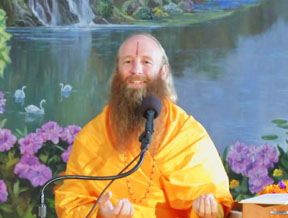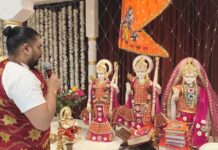 While elaborating on the meaning of the eleventh shlok of the fourth chapter, it was explained that there is only one God for all souls in the entire universe. They may belong to any country, religion, race, gender or even to any other planet! If they are worshipping God, they are worshipping the same God.
While elaborating on the meaning of the eleventh shlok of the fourth chapter, it was explained that there is only one God for all souls in the entire universe. They may belong to any country, religion, race, gender or even to any other planet! If they are worshipping God, they are worshipping the same God.
The style of worship and the description of God may vary the world over, but God is only one.
God comes to you in whatever form you worship Him
The deeper implication of this shlok is that when a soul completely surrenders to God, then God comes to that soul (appears before that soul) in his worshipped form. In other words, according to how the devotee conceives God in his mind during the devotional period, God comes to him in that form. This does not mean that God exists only according to our imagination. On the contrary – He exists simultaneously in unlimited eternal Divine forms, out of which our imagined form would also be included.
How is this possible? Consider some of the qualities of God that are commonly known: He is all-powerful, omnipresent, He contains everything within Him, and He manifests this amazingly varied and systematic universe out of a formless and lifeless power (maya).
He is also the abode of unlimited Divine powers. This being the case, is it any wonder that He would be able to manifest Himself in a Divine form?
And why should He be limited to just one Divine form? Everything about Him is unlimited: He has unlimited Divine powers, unlimited Divine virtues, unlimited Divine knowledge, and unlimited Divine bliss. It follows that God has the potential to take on unlimited Divine forms as well.
How He does it is certainly beyond human intellect. Nonetheless, we can have a brief look at how it works. Simply put, God’s unlimited powers are not necessarily all manifested at once – at any one time, He may be manifesting some, but not others. Even an ordinary person has the ability to do this.
A person has a certain amount of physical strength, but only makes use of what is required according to the situation. The same is true with learning or intelligence.
A professor of engineering has a certain level of expertise in mathematics – but when he’s instructing his child in basic arithmetic, he only manifests a fraction of his knowledge. When he lectures his university students, he reveals more of that knowledge, and when he does cutting edge research, he makes use of his complete faculties. When the same professor is in deep sleep, then he is not manifesting any of his power externally – although the power still resides within him at its full potential.
Although it’s an oversimplification, for the purpose of understanding today’s topic, we can view God in much the same way. It was previously explained that out of God’s unlimited powers, three are primary: His power of Bliss (ahladini shakti, which is the manifestation of His anand quality), His power of knowledge (samvit shakti, which is the manifestation of His chit quality) and His power of almightiness (sandhini shakti, which is the manifestation of His sat quality). These powers are manifested in different proportion to each other.
There are infinite possibilities, ranging from not manifesting any powers (like a sleeping person), to the full manifestation of all the Divine powers, and everything in between. Accordingly, God appears in different forms. It can be compared to how a person has different facets of their personality, and manifests them according to the situation.
Three main forms of God – Brahm, Parmatma and Bhagwan
These infinite possibilities are grouped into three main categories: Brahm, Parmatma, and Bhagwan.
Brahm is the form God takes when all of His powers are dormant, Parmatma is the form He takes when some proportions of His powers are outwardly manifested, and Bhagwan is the form God takes when all of His powers are manifested in full.
As Brahm, He is formless (nirakar), virtueless (nirgun), and without any discernible characteristics (nirvishesh), because all of His powers are dormant (or at least almost all of them – even a sleeping man is manifesting some power – otherwise how would he remain alive?). Like a sleeping man, Brahm does not see anything, hear anything, experience anything, do anything, think anything, know anything, or feel anything, although the potential to do all of that lies dormant within Brahm in the form of the unmanifested powers. It is similar to how the seed of a mango tree contains the roots, trunk, branches, leaves, flowers and fruit within it, but in an unmanifest (and unusable) form.
When the seed sprouts, it begins to manifest that inner potential. Similarly, as Parmatma, God manifests some of His Divine powers outwardly. As Parmatma He has a form. In fact, He has unlimited different forms, depending on the style of manifestation of His powers – those forms include Vishnu, Shiv, Durga and many other almighty forms of God. In these forms, His almightiness, omnipotence, graciousness, beauty, kindness and omniscience are revealed. He sees, hears, experiences, feels, thinks, knows, and performs actions (of course, all in His own Divine way).
When the mango tree has reached maturity, it produces flowers, and eventually bears fruit. Now it has fully manifested its inner potential. Similarly, as Bhagwan, all of the Divine powers are revealed in their totality. What form God takes when revealing the highest form of His personality as Bhagwan, will be discussed in the next article.
Disciple of Jagadguru Shree Kripaluji Maharaj
Swami Nikhilanand Ji is a Canadian born Hindu spiritual leader based in Austin, Texas. He is a sanyasi disciple and pracharak of Jagadguru Shree Kripaluji Maharaj.
Attracted to the teachings of Hinduism from a young age, Swamiji eventually let his deep spiritual longing lead him to India, where he was most fortunate to come under the guidance of Shree Kripaluji Maharaj. Thereafter, living in the ashrams of JKP, he extensively studied Hindi, the philosophy of the prime Sanskrit scriptures (Vedas, Darshan Shastras, Gita, Bhagwatam), and practiced meditation in the tradition of raganuga bhakti.
In 2003, he was given sanyas. Now, with the blessings of his Guruji, he offers satsang programs throughout America, engaging audiences with his clear explanations of Hindu philosophy coupled with inspired chanting of Sanskrit mantras and shlokas and charming nam sankirtan. His informative and compelling speeches provide practical insight into how to adopt the teachings of Sanatan Dharm into our daily lives, and inspire us to awaken our inner spiritual potential.
To stay in touch with Swami Nikhilanand Ji, like his Facebook page at https://www.facebook.com/SwamiNikhilanand or follow him on twitter at https://twitter.com/Swami_Nikhil.
Swami Nikhilanand






